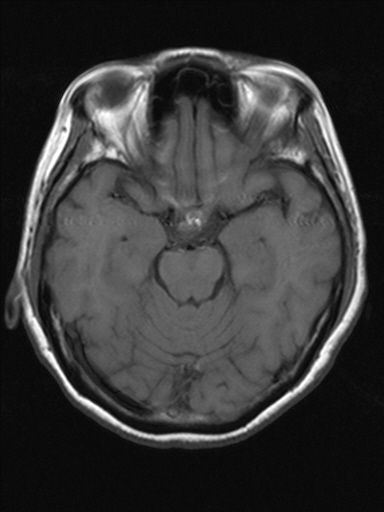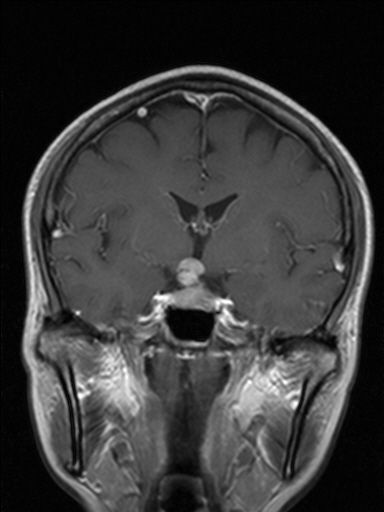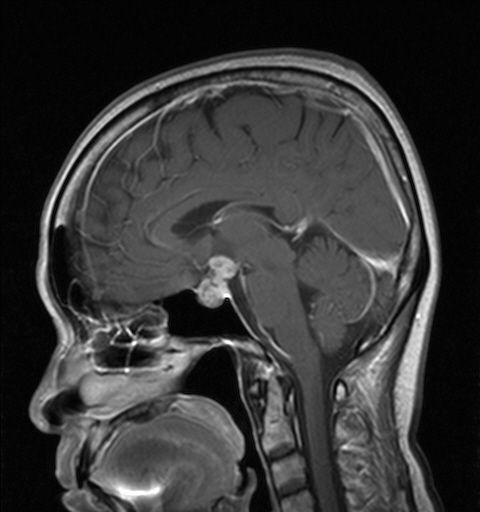Metastatic Adenocarcinoma of Pituitary Gland
A 55-year-old female presented with a one-month history of excessive thirst and polyuria. She had an operation for adenocarcinoma of the lung about 21 months ago.
Case History: A 55-year-old female presented with a one-month history of excessive thirst and polyuria. She had received an operation for adenocarcinoma of the lung about 21 months ago, with the final pathological staging being T2N0M0.

Figure 1: T2WI axial

Figure 2: T1WI axial

Figure 3: T1+C Coronal view

Figure 4: T1+C Sagittal
Findings: Her cranial MRI for newly developed symptoms disclosed a 1.2 x 1.2 x 2.2 cm sellar and suprasellar mass which extended and involved infundibulum. The tumor was isointense on both T1-weighted (T1WI) and T2-weighted (T2WI) images with small foci of hyperintensities.
After Gd-DTPA administration, contrast MRI revealed well but slightly heterogenous enhancement and findings in the rest of the brain were unremarkable. Adjacent clivus, cavernous sinus, and optic chiasm were intact.
Diagnosis: Metastatic adenocarcinoma of pituitary gland.
Discussion: Metastases to the sellar region account for approximately 1 percent of sellar masses on which a biopsy was performed, and by far most commonly arise from breast and lung adenocarcinomas. Pituitary metastases were reported to occur in 3 percent to 23 percent of cancer patients in an autopsy series. Solitary pituitary metastasis is uncommon and was reported to occur in about 3.1 percent sellar and juxtasellar abnormalities by MRI.
Apparent symptoms from metastasis to pituitary gland are uncommon because widespread metastatic disease or overwhelming systemic complications of original malignancy might mask symptoms of hypopituitarism. The most common presenting symptoms: diabetes insipidus, anterior hypopituitarism, headache, visual defects, and ophthalmoplegia. The prognosis of patients with pituitary metastasis is poor, and the mean survival length is six to seven months in previous clinical series. It is not because of the location per se but because of the extent of systemic disease.
Differential diagnosis: There are more than 15 diseases for a sellar/suprasellar mass. The most common five account for more than 75 percent of all suprasellar masses in adults, and most other lesions stand for less than 1 percent to 2 percent each, including pituitary adenoma which is the most common one, meningioma, craniopharyngiomas, hypothalamic/chiasmatic glioma, and aneurysm.
Diagnostic clues: Imaging findings prefer the diagnosis of metastasis for a sellar/suprasellar mass:
Loss of posterior bright spot of normal pituitary gland
Infiltration of stalk causing thick stalk
Isointensity on both T1- and T2-weighted MR images
Respect the diaphragm” early in the disease: Metastatic tumor usually had rapid growing and does not have enough time length to expand the diaphragm sellae, as contrast to the enlarged diaphragm in pituitary adenoma
Invasion of juxtasellar structures such as cavernous sinus, sphenoid sinus or clivus
Usually suprasellar or combined intrasellar and suprasellar in position: probably due to lack of blood-brain-barrier in these suprasellar structures.
References:
(1) Johnsen DE, Woodruff WW, Allen IS, et al. MR imaging of the sellar and juxtasellar regions. Radiographics 1991;11(5): 727-58
(2) Evanson J. Imaging the pituitary gland. Imaging 2002;14(2):93-102
(3) Morita A, Meyer FB, Laws ER Jr. Symptomatic pituitary metastases. J Neurosurg 1998;89(1): 69-73
Chih-Chun Wu, MD, radiologist in Medical Imaging Department, Cheng Hsin General Hospital, Taipei, Taiwan
The Reading Room Podcast: Current Perspectives on the Updated Appropriate Use Criteria for Brain PET
March 18th 2025In a new podcast, Satoshi Minoshima, M.D., Ph.D., and James Williams, Ph.D., share their insights on the recently updated appropriate use criteria for amyloid PET and tau PET in patients with mild cognitive impairment.
Meta-Analysis Shows Merits of AI with CTA Detection of Coronary Artery Stenosis and Calcified Plaque
April 16th 2025Artificial intelligence demonstrated higher AUC, sensitivity, and specificity than radiologists for detecting coronary artery stenosis > 50 percent on computed tomography angiography (CTA), according to a new 17-study meta-analysis.